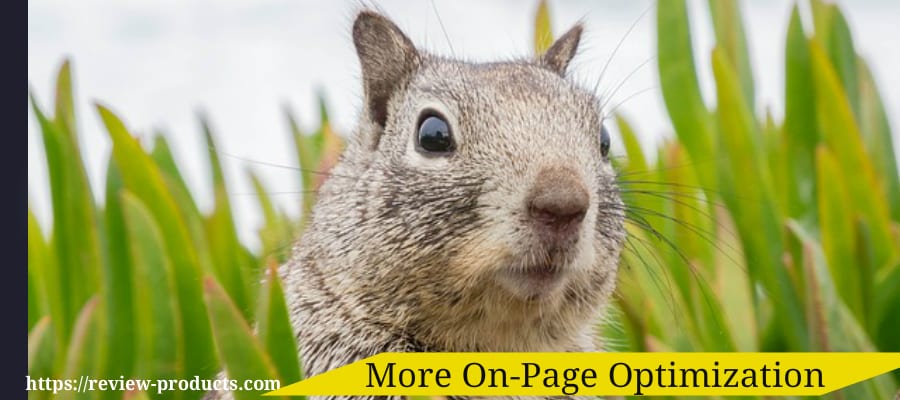Conquer On-Page SEO in 2018 and beyond the years to come has placed pressure on web page creators to write great content for the giant Search Engine Google. The good news is regardless of all the changes that have happened, it’s still possible to separate our SEO into mostly ‘on page’ and ‘off the page.’ On the page, refers to all the strategies that you can use within your pages to get Google interested in your site. And this begins with content – and it starts by producing a stronger understanding of the complex changes Google has gone through in recent times.
How to Make Excellent Content

One of the first things you’re going to need to do is to fill your site with high content and to use your keywords throughout. There’s a fine line to be walked here: you need to repeat the phrase a few times to ensure that you create that association, but at the same time, you also need to make sure that you don’t overdo it and thereby appear to be spamming.
Too vague? As mentioned, it’s now agreed that the optimum ‘keyword density for on-site content is 1-2%. That means you can use your phrase once per every 100-200 words. But you also need to use your common sense a little: some keywords are easier to use naturally than others and making sure that your content sounds natural should always be the number one concern. Some keywords will be hard not to repeat 100 times! Others will never feel that they can come up naturally.
The user always comes first. So, if you can’t fit the keyword in naturally anywhere, just forget it and use it in your image alt-text, etc. The length of your posts is also an important consideration. Back in the days of spammy-SEO, almost every post was 500 words long. Today, you’ll have the most success by writing posts that are longer and more in-depth. Imagine that your reader is going to sit down with a cup of tea and really dive deep into the subject – that’s the kind of experience that you should be delivering!
This has another advantage because it means that you can repeat your keyphrase a lot more while keeping your density low. If you repeat your keyword 100 times and your content is 1,000 words long then, that’s a 10% density. If your content is 5,000 words long, that’s 2% density! Of course, 5,000 words is too long for most blog posts. Instead, the general consensus is that an ideal blog post will be somewhere in the region of 800-1,500 words.
But again: remember that you serve your visitors first and foremost. These are the people that you want to impress, and that means that you shouldn’t worry too much about length – do what comes naturally to your subject matter. Oh, and while you’re at it – try to vary the lengths of your posts a little. This again looks more natural and suggests to Google that you’re not following a strict ‘formula’ of any kind!
Introducing a Conversational Google

At the same time, you also need to consider something called ‘LSI’ or ‘Latent Semantic Indexing.’ This is basically a fancy term that explains how Google now understands actual meaning rather than just looking to match words. The way it does this is at least partly by looking for synonyms and related terms when trying to answer questions. In short, don’t just use the exact keyphrase but be sure to use lots of relevant and similar language.
Bear in mind that the above fact is important partly because it can prevent a mismatch between searches. If someone searches for a homonym, like ‘duck,’ how does Google know whether they mean the animal or the movement? Simple: by looking for related terms like ‘duckling’ and ‘feather’ or perhaps ‘dodge’ and ‘dive.’ At the same time, the use of synonyms and related language again shows Google that there is lots of content revolving around the same topic – it’s not just a case of having mentioned the search term a few times in an otherwise irrelevant piece of writing. Search Engine Optimization (SEO) Starter Guide.
So if you’re writing about bicep workouts, then you need to make sure to include lots of related languages, like:
- Arms Triceps
- Dumbbells Training
- Weightlifting
- Doing this will confirm the subject matter of your site and will look a lot more natural and useful than if you just use the phrase. And for the same reason, it can also be a good idea to use variations on your keyphrase and to have
- ‘secondary’ search terms.
For example, if your key phrase is ‘build massive arms,’ then you should also try to include the terms ‘build big arms,’ ‘build big biceps,’ ‘get big biceps’ etc. Google now knows that this means the same thing but won’t be as likely to penalize you for keyword stuffing. It also makes you look like a better writer for your visitors! Mostly, try to keep in mind that Google no longer works in attempting to match the search terms precisely in your content. Ses these free SEO tools
You can see this yourself when you search Google. Search ‘get big arms,’ and many of the results that come up won’t actually include those precise words! Likewise, linking out to relevant resources might help Google to understand the topic of your pages and posts better, while also demonstrating that you are trying to provide extra value to your visitors.
Schemas and Structured Data

And on that same note, you should also look at rich snippets. Using ‘structured data’ you can highlight to Google certain critical elements of your content: recipes, dates, company names, scores, etc. This helps Google show some of that information in the SERPs (search engine results pages) and thereby attracts more visitors to your site. Some plugins will let you do this quickly, or you can do it through meta tags.
Either way, you’ll use this to do things like highlighting the ingredients in a recipe, or the showtimes of play, or the score in a review. This is important because it lets Google understand your content even better than it is already able to. Google is no longer just a search engine but rather an AI – this is the direction that Google is heading in and being able to understand and utilize this might just be the key to SEO success in the future.
Right now, using structured data and rich snippets will allow information from your site to appear directly in the SERPs. This way, if some one searches for a recipe, they’ll be able to see the ingredients for your version before they even click on your link! This means your listing will take up more space and demonstrate the value of your site. And all that, in turn, means that you’re going to attract more clicks than a website without that information.
Design and Layout to Conquer On-Page SEO in 2018 and Beyond 2019

The next element of on-page optimization is the site design itself. Using breadcrumbs, for instance, can help a lot, as can using alt-tags for your images so that Google knows what they are off. More important is the actual function of your website: does the page load quickly? Is it mobile-friendly? Mobile-friendliness, in particular, is something you entirely cannot ignore in 2017 and beyond.
Concerning the actual design and function of your website, the primary goals are to ensure your site will load quickly and that it will look great on mobile. Again, this helps to keep people on your site longer because it will be enjoyable for them to be there. Avoid using too many plugins which will slow you down and try not to inundate your visitors with adverts and pop-overs.
Here is a thought for you to consider when writing your blog which goes a long way in keeping visitors attention. Add light colors like bright blues which can actually help to keep people on the page reading longer. A style like this helps the visitor to feel more relaxed while viewing the web page. Also, consider this when picking your theme. Likewise, choose a topic that will adapt to the size of the display seeing it and make sure that you take advantage of things like caching to keep your site nippy.
Themes that do this are called ‘responsive,’ in that they respond to the shape and size of the display they’re being viewed on. This works by removing certain elements, rearranging menus, etc., and by shrinking images. Note that mobile-friendliness also means things like having large buttons (which are easier to click with a finger rather than a mouse) and also avoiding ‘mouse-over’ drop-down menus that again can’t be operated on mobile without a mouse.
The best way to ensure that your website is responsive, and your site looks good over different screens and still able to conquer on-page SEO in 2018 and beyond is that, it still encourages maximum engagement, is to use WordPress. WordPress is a CMS (Content Management System) that makes it incredibly easy to build a responsive website and then add a custom theme that you have downloaded (free or paid) or made yourself. Using WordPress removes much of the guesswork and makes it very easy for you to implement new layouts and even to add things like rich snippets by downloading the right plugins.
There’s a massive online community to support your development, and the tool is used by many of the most significant sites on the net – meaning that it is a ‘proven quantity’ as far as SEO goes. Seeing as WordPress is free, you’re really just making life harder for yourself by using anything other than it to build your website.
More On-Page Optimization

As mentioned, there are a few miscellaneous tips that can also help you to improve your on-page SEO. For example, it’s generally accepted that using copyright notices and legal disclaimers can be seen as a positive sign by Google as these will make your website look more professional and more like a ‘real business.’ Think as well about how you’re going to help Google find the content within your site.
Having a sitemap can be very helpful for indexing for example. And you need to avoid using images that have text in them and definitely avoid the use of Adobe Flash, seeing as Google is unable to read that type of copy. You can also insert your search terms in your site’s code – by including it in file names (the file name of an image for example) and including it in the permalinks (the URLs of specific pages – which should match the title of your posts).
Then you have the behavior of your visitors. In other words: how long are your visitors staying on your page? Do they click lots of internal links? Do they scroll down the page? Are they leaving comments? Google wants to see that your site is offering value to your visitors and the best way they can do that is by looking to see if people are actually enjoying the content you’ve created. Your site design is all about getting your visitors to spend a long on your page then and to interact with it.
You can do this by using ‘related posts’ and by making your comments section appear more exciting and easier to use. But you also do it by just ensuring that your site looks great, performs well, and is filled with compelling and relevant content. Try to avoid adverts or bad design elements that are going to instantly put people off and cause them to leave your website!
Remember: Google wants to see that people are spending time on your website and the best way you can ensure this happens is by making content that people want to read. Moreover, you need to ensure that that content is presented in a way that encourages people to stick around. Forget dense blocks of text with no images.
Instead, create content with lots of headers, that are well spaced out, and that use large beautiful pictures throughout. Regarding the actual writing, try to use a narrative structure where possible to really pull people in. Tell a story, use cliffhangers and make it impossible for your visitors not to move down to the next line!
Ultimately, it comes down to making sure that you’re providing the very best experience for your visitors – but doing so in such a way that Google can see and understand that that is the case. Here is an example of writing for a search engine and still keeping your readers in mind.






